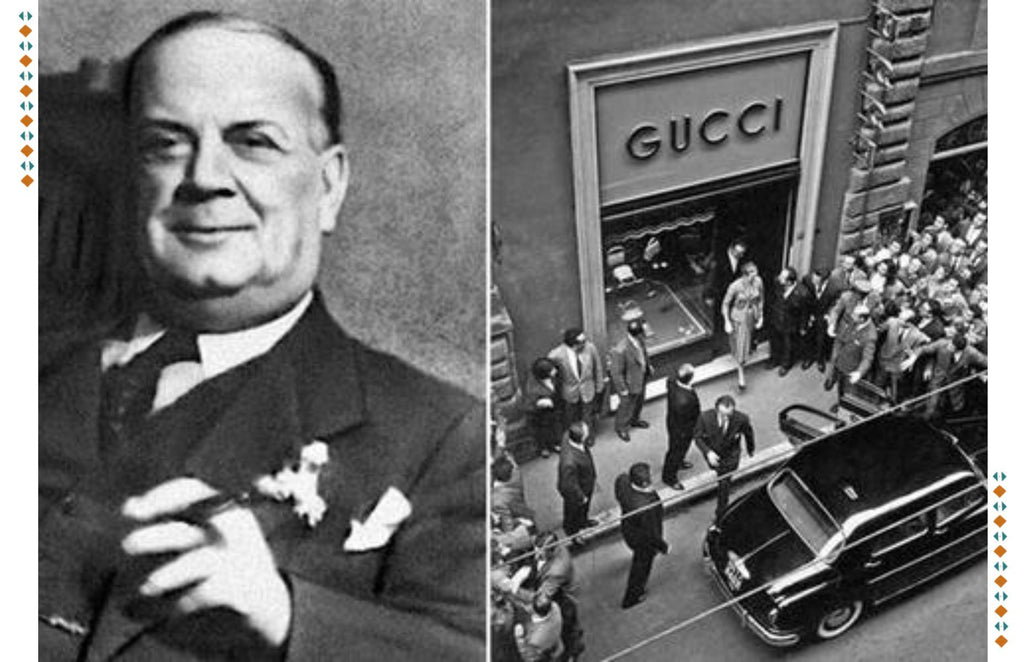Some people are fortunate enough to avoid the years of hard work required by others. Some people think it's a hybrid of the two. The story of Gucci's meteoric rise from relative obscurity to global dominance is one of sheer grit and, as a result, opulence.
The name Gucci conjures up images of A-listers, opulence, and fame. This label has been synonymous with class and sophistication for decades.
Women all around the globe adore Gucci handbags, and the brand's other accessories are equally well-known. There is no doubt that the most recognizable items from this label are the bamboo-handled purse and the green-and-red buckle moccasin. The present success of the luxury brand can only be understood by looking back at its origins.
The Founder of Gucci

One of the most prestigious Italian fashion houses in the world, Gucci, turned one hundred last year. The firm was established by Guccio Gucci in Florence in 1921, and its name immediately became synonymous with luxurious leather suitcases crafted in Tuscany.
The son of Gabriello Gucci, a poor leather worker from San Miniato, and Elena Santini, a dressmaker from Lastra a Signa, Guccio Gucci was born in Florence, Italy, in 1881. At the age of seventeen, he left his homeland for London, where he worked as a lift boy at the Savoy Hotel, where he was inspired by the riches of the visitors who carried the expensive baggage, and where he learned what differentiates great bags from cheap ones, and how this impacts the design.
Inception of Gucci

Following the Armistice that ended World War I, Gucci relocated back to Italy. In 1921, he opened "La Casa Gucci" (House of Gucci) at number seven on Via Della Vigna Nuova, where he sold leather goods and bags in classic styles made from Tuscany's finest materials.
It was common knowledge that Guccio had a thorough understanding of the fabrics that would go into his products and how they would be combined to attractiveness. His line of leather handbags was stunning, and it did quite well in the market.
Florentine nobility and upper-class citizens quickly caught wind of this innate talent and set out to acquire its fruits. Indeed, the name became ubiquitous very rapidly, becoming one of the most famous among the country's upper crust.
After gaining enough notoriety, he was able to start selling advertisements for his own workshop, which he set up in the back of his shop and began using to manufacture his goods.
Guccio was preoccupied with expanding his company until a problem hit. Leather was scarce in Italy under Benito Mussolini's dictatorship in the year 1935. The foundation of Gucci's business was leather, but Guccio knew how to fix the problem: he switched to using silk for most of Gucci's products.
The expansion of the company

After establishing his company as little more than a small shop, Guccio Gucci tragically passed away in 1953. It was his sons Aldo, Vasco, and Rodolfo Gucci who carried on the family business after his passing, and the Gucci label went on to achieve legendary status among A-list actors and actresses.
Rodolfo oversaw all of the business's operations in Italy, including opening a storefront in Milan, while Vasco was in charge of the studio's home city. After leaving Italy, Aldo created the first Gucci shop outside of the country in New York.
The primary objective of Aldo, Vasco, and Rodolfo, the successors, was to expand the label's presence, first in Rome, then in Milan, and then throughout the United States and Europe in the 1950s. Yes, they definitely did. In 1953, in honor of Guccio Gucci's time spent as a lift boy at New York's Savoy Plaza Hotel, the first Gucci boutique opened for business. The founder, though, passed away only days after the book came out.
Series of events

The Gucci tote bag with a bamboo handle was created in 1947 and quickly became a best-seller among women. Quickly, the bag was embraced by the Hollywood elite.
The Trade Palace in Florence is home to the Gucci Museum, which opened to the public in 2011. Included are the brand's original products, such as bags, sports equipment, and the floral print design, as well as a riding suit donated by Charlotte Casiraghi, Princess of Monaco.
When Gucci hired Tom Ford as its new CEO in the late 1990s, it gained an evident figure at the helm. The young designer revolutionized the company by reintroducing iconic Gucci pieces like bags and loafers with a modern twist.
During his time at Gucci, Tom updated the brand by launching innovative new collections and reimagining the company's signature advertising campaigns and models. Tom Ford departed Gucci after a number of successful years at the helm to start his own company, which has now become an international phenomenon.
Although the company has had its share of successes and failures, Gucci is still among the most recognizable names in the fashion world. With each new collection, this firm continues to wow with groundbreaking innovations, establishing Gucci as the go-to label for those who refuse to let their own style fade.
FAQ
Who is the founder of the Gucci brand?
Guccio Giovanbattista Giacinto Dario Maria Gucci was the founder of the brand Gucci.
Does the Gucci family still own Gucci?
No, the fashion house Gucci is now owned by the brand Kering.
What made Gucci famous?
When it comes to luxury goods, such as leather goods, clothing, watches, and jewelry, Gucci is a name that needs no introduction. Products from this company represent the pinnacle of skill in terms of creativity, originality, aesthetic value, and complexity.
We also happen to be a magnet for suggestions, and would love to catch yours….throw us yours on hello@fabriclore.com





